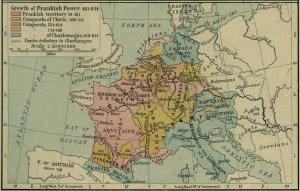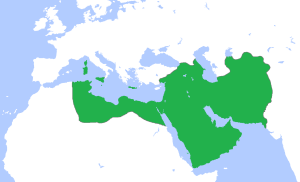Archive for the ‘Abbasids’ Category
Timeline of the Islamic Caliphate
Posted in Abbasids, Arab, Caliphates, Islam, Khawarismisha, Mongols, Muslims, Ottomans, Prophets, Umayyads on September 20, 2010| Leave a Comment »
Building of Baghdad
Posted in Abbasids, Baghdad, Caliphates, Damascus, Persian, Scholars on January 4, 2010| Leave a Comment »

Abbasid Palace in Baghdad
On 30 July 762 the Muslim Abbasid Caliph Abu-Ja’far Al-Mansur founded the city. Mansur believed that Baghdad was the perfect city to be the capital of the Islamic empire under the Abbasids. Mansur loved the site so much he is quoted saying, “This is indeed the city that I am to found, where I am to live, and where my descendants will reign afterward”. The city’s growth was helped by its location, which gave it control over strategic and trading routes (along the Tigris to the sea and east-west from the Middle East to the rest of Asia). Monthly trade fairs were also held in this area. Another reason why Baghdad provided an excellent location was due to the abundance of water and its dry climate. Water exists on both north and south ends of the city gates, allowing all households to have a plentiful supply, which was very uncommon during this time. Baghdad reached its greatest prosperity during the reign of the caliph Harun al-Rashid in the early 9th century.
Four years before Baghdad’s foundation, in 758, Mansur assembled engineers, surveyors, and art constructionists from around the world to come together and draw up plans for the city. Over 100,000 construction workers came to survey the plans; many were distributed salaries to start the building of the grand city. The framework of the city itself is two large semicircles about twelve miles (19 km) in diameter. July was chosen as the starting time because two astronomers, Naubakht Ahvaz and Mashallah, believed that the city should be built under the sign of the lion, Leo. Leo is significant because he is the element of fire and symbolises productivity, pride, and expansion. The bricks used to make the city were 18” on all four sides.
The city of Baghdad formed two vast semi-circles on the right and left banks of the Tigris, twelve miles in diameter. The numerous suburbs, covered with parks, gardens, villas and beautiful promenades, and plentifully supplied with rich bazaars, and finely built mosques and baths, stretched for a considerable distance on both sides of the river. In the days of its prosperity the population of Baghdad and its suburbs amounted to over two millions! The palace of the Caliph stood in the midst of a vast park several hours in circumference which beside a menagerie and aviary comprised an inclosure for wild animals reserved for the chase. The palace grounds were laid out with gardens, and adorned with exquisite taste with plants, flowers, and trees, reservoirs and fountains, surrounded by sculptured figures. On this side of the river stood the palaces of the great nobles. Immense streets, none less than forty cubits wide, traversed the city from one end to the other, dividing it into blocks or quarters, each under the control of an overseer or supervisor, who looked after the cleanliness, sanitation and the comfort of the inhabitants.
The water exits both on the north and the south were like the city gates, guarded night and day by relays of soldiers stationed on the watch towers on both sides of the river. Every household was plentifully supplied with water at all seasons by the numerous aqueducts which intersected the town; and the streets, gardens and parks were regularly swept and watered, and no refuse was allowed to remain within the walls. An immense square in front of the imperial palace was used for reviews, military inspections, tournaments and races; at night the square and the streets were lighted by lamps.
There was also a vast open space where the troops whose barracks lay on the left bank of the river were paraded daily. The long wide estrades at the different gates of the city were used by the citizens for gossip and recreation or for watching the flow of travelers and country folk into the capital. The different nationalities in the capital had each a head officer to represent their interests with the government, and to whom the stranger could appeal for counsel or help.

Abbasid silver dirham from the time of the Caliph Al-Muqtadir (908-932 AD) - Baghdad
Baghdad was a veritable City of Palaces, not made of stucco and mortar, but of marble. The buildings were usually of several stories. The palaces and mansions were lavishly gilded and decorated, and hung with beautiful tapestry and hangings of brocade or silk. The rooms were lightly and tastefully furnished with luxurious divans, costly tables, unique Chinese vases and gold and silver ornaments.
Both sides of the river were for miles fronted by the palaces, kiosks, gardens and parks of the grandees and nobles, marble steps led down to the water’s edge, and the scene on the river was animated by thousands of gondolas, decked with little flags, dancing like sunbeams on the water, and carrying the pleasure-seeking Baghdad citizens from one part of the city to the other. Along the wide-stretching quays lay whole fleets at anchor, sea and river craft of all kinds, from the Chinese junk to the old Assyrian raft resting on inflated skins.
The mosques of the city were at once vast in size and remarkably beautiful. There were also in Baghdad numerous colleges of learning, hospitals, infirmaries for both sexes, and lunatic asylums.

Mosque in Baghdad
The four surrounding walls of Baghdad were named Kufa, Basra, Khurasan, and Damascus; named because their gates pointed in the directions of these destinations. The distance between these gates was a little less than a mile and a half. Each gate had double doors that were made of iron; since the doors were so heavy it took several men to open and close them. The wall itself was about 145 feet (44 m) thick at the base and about 39 feet (12 m) thick at the top. Also, the wall was 98 feet (30 m) high, which included merlons, a solid part of an embattled parapet usually pierced by embrasures. This wall was surrounded by another impressive wall that consisted of 165 feet (50 m) and was extremely thick. The second wall had towers and rounded merlons, which surrounded the towers. This outer wall was protected by solid glacis, which is made out of bricks and quicklime. Beyond the outer wall was a water filled moat.
The Deal Between Haroun and Charlemagne
Posted in Abbasids, Al-Andalus, Arab, Baghdad, Byzantine , Caliphates, Christians, Cordoba, Europe, Franks, Iberia, India, Iraq, Islam, Jerusalem, Jews, Khawarismisha, Muslims, Umayyads on August 4, 2009| Leave a Comment »
At the time of the Abbasid Caliph in Baghdad, Haroun Al-Rasheed, in 772 A.D. the king of france, Charlemagne son of Pepin the short (i.e., Pepin III), Led his army of the Franks to hold a seige in order to submit Rome of Italy to his rule. The siege lasted until the spring of 774 A.D., when Charlemagne visited the pope in Rome. There he confirmed his father’s grants of land, with some later chronicles claiming—falsely—that he also expanded them, granting Tuscany, Emilia, Venice, and Corsica then he conquered Benevento in 787 A.D. to have all of Italy under his power. In 779 A.D. he led the army to conquer Lombardy and then he he conquered Saxonia and proceeded to convert the conquered to Roman Catholicism, using force where necessary. In 794 A.D., he was made to renounce any claim to Bavaria for himself and his family (the Agilolfings) at the synod of Frankfurt.
Charlemagne in 793 A.D. had the desire of being more of a protector of Christian pilgrims going to the Holy Land than Byzantine. He had a deal with Haroun The Caliph to provide this protection, while the Franks would fight the Umayyads in Al-Andalus (in the Iberian Peninsula) until they are being demolished. Four years later in 797 A.D., the Caliph Haroun of Baghdad, the city of modern civilization at that time, sent gifts with the delegates of Charlemagne headed by a Jewish minister called Isaac. The gifts included rare Indian fabric, an Asian elephant called “Abul-Abbas”, and a clock. When the gift arrived, people of Charlemagne thought the clock was a sort of Eastern magic and they decided to break it down, yet Charlemagne heard about their decision and stopped them. Haroun in 798 A.D. sent to Charlemagne an offer of scholarships for the Franks to send their young students to study medicine, geometry, Algebra, and Astronomy in the schools of Baghdad and Khawarizm.
In 797 Barcelona, the greatest city of the region, fell to the Franks when Zeid, its governor, rebelled against Cordoba and, failing, handed it to them. The Umayyad authority recaptured it in 799. However, Louis of Aquitaine marched the entire army of his kingdom over the Pyrenees and besieged it for two years, wintering there from 800 to 801, when it capitulated. The Franks continued to press forwards against the emir. They took Tarragona in 809 and Tortosa in 811. The last conquest brought them to the mouth of the Ebro and gave them raiding access to Valencia, prompting the Emir al-Hakam Ito recognise their conquests in 812.




